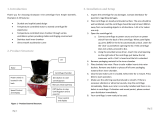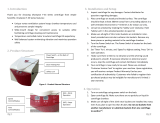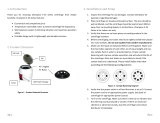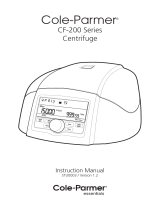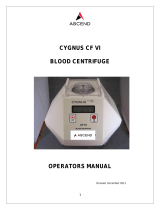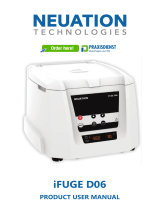Page is loading ...

Operating Manual
Refrigerated Centrifuge
1-14K
from serial no. 135550
Please retain for later use!
Version 05/2010, Rev. 1.8 of 01/09/2011- sb
Translation of the original operating manual


1-14K
Version 05/2010, Rev. 1.8 of 01/09/2011- sb 3
Translation of the original operating manual
In case of inquiries please state the following number:
Serial number:
Copyright by
Sigma Laborzentrifugen GmbH
An der Unteren Söse 50
37520 Osterode am Harz
Germany
Phone +49 (0) 55 22 / 50 07-0
Fax +49 (0) 55 22 / 50 07-12
E-mail: info@sigma-zentrifugen.de
For service
please use our
service request
form on our website:
www.sigma-zentrifugen.de → [Service Area]
or contact:
Phone +49 (0) 55 22 / 50 07-84 25
Fax +49 (0) 55 22 / 50 07-94 25
E-mail: service@sigma-zentrifugen.de


1-14K
Table of Contents
Version 05/2010, Rev. 1.8 of 01/09/2011- sb 5
Translation of the original operating manual
Table of Contents
1 General Information 9
1.1
Importance of the Operating Manual ..........................................................................9
1.2
Intended Use..............................................................................................................9
1.3
Warranty and Liability.................................................................................................9
1.4
Copyright..................................................................................................................10
1.5
Standards and Regulations ......................................................................................10
1.6
Scope of Supply.......................................................................................................10
2 Design of the Centrifuge 11
2.1
Overview..................................................................................................................11
2.2
Name Plate ..............................................................................................................11
3 Safety 12
3.1
Marking of the Unit...................................................................................................12
3.2
Explanation of the Symbols and Notes.....................................................................13
3.3
Responsibility of the Operator ..................................................................................14
3.4
Operating Personnel.................................................................................................14
3.5
Informal Safety Instructions......................................................................................14
3.6
Safety Instructions....................................................................................................15
3.6.1
Electrical Safety..........................................................................................15
3.6.2
Mechanical Safety ......................................................................................15
3.6.3
Fire Prevention ...........................................................................................16
3.6.4
Chemical and Biological Safety...................................................................16
3.6.5
Safety Instructions for Centrifugation..........................................................17
3.6.6
Resistance of Plastics.................................................................................17
3.6.7
Service Life of Rotors and Accessories.......................................................17
3.7
Safety Devices .........................................................................................................18
3.7.1
Lid Lock Device ..........................................................................................18
3.7.2
System Check.............................................................................................18
3.7.3
Ground Wire Check ....................................................................................18
3.8
Measures in the Event of Hazards and Accidents.....................................................19
3.9
Remaining Hazards..................................................................................................19
4 Storage and Transport 20
4.1
Dimensions and Weight............................................................................................20
4.2
Storage Conditions...................................................................................................20
4.3
Notes on Transport...................................................................................................20

1-14K
Table of Contents
6 Version 05/2010, Rev. 1.8 of 01/09/2011- sb
Translation of the original operating manual
5 Set-up and Connection 21
5.1
Unpacking the Centrifuge.........................................................................................21
5.2
Transport Safety Device...........................................................................................21
5.3
Installation Site.........................................................................................................21
5.4
Power Supply...........................................................................................................22
5.4.1
Connection..................................................................................................22
5.4.2
Fuses on site ..............................................................................................22
6 Using the Centrifuge 23
6.1
Initial Start-Up...........................................................................................................23
6.2
Switching the Centrifuge ON.....................................................................................23
6.2.1
Opening and Closing the Lid.......................................................................23
6.2.2
Installation of Rotors and Accessories ........................................................23
6.2.2.1
Installation of the Rotor...............................................................23
6.2.2.2
Installation of the Microhematocrite Rotor...................................24
6.2.2.3
Installation of Accessories...........................................................25
6.2.2.4
Tubes..........................................................................................25
6.3
Operation..................................................................................................................26
6.3.1
Operating Panel..........................................................................................26
6.3.2
Centrifuge Display.......................................................................................26
6.3.3
Starting a Centrifugation Run......................................................................27
6.3.4
Interrupting a Centrifugation Run................................................................27
6.3.5
Interrupting a Deceleration Process............................................................27
6.3.6
Speed / Relative Centrifugal Force (RCF)...................................................27
6.3.6.1
Changing the Speed/RCF Value during Centrifugation ...............27
6.3.7
Runtime......................................................................................................28
6.3.7.1
Changing the Runtime during Centrifugation...............................28
6.3.7.2
Short Run....................................................................................28
6.3.7.3
Continuous Run..........................................................................28
6.3.7.4
Temperature...............................................................................29
6.3.7.5
Precooling Program "Precool".....................................................29
6.3.7.6
Softstart and Softstop Function...................................................30
6.3.8
Rotor Selection...........................................................................................30
6.3.9
Programs....................................................................................................31
6.3.9.1
Saving the current settings..........................................................31
6.3.9.2
Calling up stored programs.........................................................31
6.4
Switching the Centrifuge OFF...................................................................................31
7 Malfunctions and Error Correction 32
7.1
General Malfunctions................................................................................................32
7.1.1
Emergency Lid Release..............................................................................33
7.2
Error Codes..............................................................................................................34
7.3
Service Contact........................................................................................................35

1-14K
Table of Contents
Version 05/2010, Rev. 1.8 of 01/09/2011- sb 7
Translation of the original operating manual
8 Maintenance and Service 36
8.1
Maintenance.............................................................................................................36
8.1.1
Centrifuge...................................................................................................36
8.1.2
Accessories................................................................................................37
8.1.2.1
Plastic Accessories.....................................................................37
8.1.2.2
Aluminium Accessories...............................................................37
8.1.3
Rotors.........................................................................................................37
8.1.4
Microhematocrite Rotor...............................................................................38
8.2
Sterilization and Disinfection of the Rotor Chamber and Accessories.......................38
8.2.1.
Autoclaving.................................................................................................39
8.3
Service.....................................................................................................................40
8.4
Return of defective parts ..........................................................................................41
9 Disposal 42
9.1
Disposal of the Centrifuge ........................................................................................42
9.2
Disposal of the Packaging........................................................................................42
10 Technical Data 43
10.1
Ambient Conditions..................................................................................................43
11 Appendix 44
11.1
Suitable Accessories................................................................................................44
11.2
Grafical Representation of the Rotors.......................................................................46
11.3
Formulae - Mathematical Relations..........................................................................47
11.3.1
Relative Centrifugal Force (RCF)................................................................47
11.3.2
Density .......................................................................................................47
11.3.3
Speed-Gravitational-Field-Diagram.............................................................47
Table of rotors and accessories with a different service life......................................49
Resistance Data.......................................................................................................50
EC-Declaration of Conformity...................................................................................53
12 Index 55


1-14K
General Information
Version 05/2010, Rev. 1.8 of 01/09/2011- sb 9
Translation of the original operating manual
1 General Information
1.1 Importance of the Operating Manual
A fundamental requirement for the safe and trouble-free operation of
the centrifuge is to be familiar with the fundamental safety instructions
and all possible hazards.
The operating manual includes important information concerning the
safe operation of the centrifuge.
This operating manual and in particular the notes on safety and
hazards must be observed by all persons operating the centrifuge.
In addition, the local rules and regulations for the prevention of
accidents must be complied with.
1.2 Intended Use
Centrifuges are power-driven machines that separate liquids from
solid matter, liquid mixtures, or solid mixtures by centrifugal force.
They are solely intended for this purpose. Any other use beyond this
area of application is regarded as improper use.
SIGMA Laborzentrifugen GmbH cannot be held liable for any damage
resulting from such improper use.
The intended use also includes
• observation of all the notes and instructions included in the
operating manual and
• compliance with the care, cleaning, and maintenance
instructions.
1.3 Warranty and Liability
The warranty and liability are subject to our "General Conditions" that
were distributed to the operator upon the conclusion of the contract.
Warranty and liability claims are excluded if they are due to:
• Improper use.
• Non-compliance with the safety instructions and hazard warnings
in the operating manual.
• Improper installation, start-up, operation, and maintanance of the
centrifuge.

1-14K
General Information
10 Version 05/2010, Rev. 1.8 of 01/09/2011- sb
Translation of the original operating manual
1.4 Copyright
The copyright concerning the operating manual remains Sigma
Laborzentrifugen GmbH.
The operating manual is solely intended for the operator and their
personnel. It includes instructions and information that may not be
• duplicated,
• distributet, or
• communicated in any othe way
neither in full nor in parts.
Non-compliance may be prosecuted under criminal law.
1.5 Standards and Regulations
EC Declaration of Conformity (page 53).
1.6 Scope of Supply
The centrifuge comprises:
• 1 connection cable depending on the voltage
variant
• 1 socket wrench (emergency release) part no. 930 014
• 1 rotor fastening nut part no. 80 301
• 20 ml slushing oil part no. 70 104
• Spare fuses part no. 70 102 (230V)
or part no. 70 106 (120V)
Documentation:
Operating Manual incl. EC Declaration of Conformity (page 53)
Accessories
according to your order, our order confirmation, and our delivery note.

1-14K
Design of the Centrifuge
Version 05/2010, Rev. 1.8 of 01/09/2011- sb 11
Translation of the original operating manual
2 Design of the Centrifuge
2.1 Overview
1 Lid
2 Display
3 Set key
4 Program key
5 Arrow keys
6 Precool key
7 Start / stop key
8 Lid key
Fig. 2.1: Total view of the centrifuge
9 Mains power input
10 Mains switch
11 Name Plate (see 2.2)
Fig. 2.2: Rear view of the centrifuge
2.2 Name Plate
1 Manufacturer and registered
office
2 Type name
3 Serial number
4 Max. speed
5 Kinetic energy
6 Max. density
7 Nominal voltage
8 Input fuse
9 Symbol for special disposal
(see chapter 9)
10 CE mark in accordance with
the directive 94/9/EC
11 Part number
12 Year of manufacture
13 Power consumption
Fig. 2.3: Example of a name plate
1
2
3
4
5
6
7
8
9
10
11
12
13
1
2
3
4
5
6
7
8
9
10
11

1-14K
Safety
12 Version 05/2010, Rev. 1.8 of 01/09/2011- sb
Translation of the original operating manual
3 Safety
3.1 Marking of the Unit
International symbols used for SIGMA centrifuges:
Gefährliche elektrische Spannung
Dangerous voltage
Courant haute tension
Achtung, Betriebsanleitung lesen
Attention, consult instruction manual
Attention, consulter mode d'emploi
I
Ein (Netzverbindung)
On (Power)
Marche (mise sous tension)
O
Aus (Netzverbindung)
Off (Power)
Arrêt (mise hors tension)
Schutzleiteranschluss
Protective earth (ground)
Liaison à la terre
Erde
Earth (ground)
Terre
Netzstecker ziehen
Unplug mains plug
Tirer la fiche de prise
Vorsicht Quetschgefahr
Caution! Risk of bruising
Attention! Danger de blessure
→
Drehrichtungspfeil
Arrow direction of rotation
Flèche sens de rotation
Heiße Oberfläche
Hot surface
Surface chaude
Nicht mit dem Hausmüll entsorgen
Do not dispose as part of domestic waste
Ne pas jeter avec les déchets ménager

1-14K
Safety
Version 05/2010, Rev. 1.8 of 01/09/2011- sb 13
Translation of the original operating manual
3.2 Explanation of the Symbols and Notes
This operating manual uses the following names and symbols to
indicate hazards:
This symbol stands for a direct hazard to the life and health of
persons.
Non-observance of these symbols causes serious health problems up
to life-endangering injuries.
This symbol stands for a direct hazard to the life and health of
persons due to electrical voltage.
Non-observance of these symbols causes serious health problems up
to life-endangering injuries.
This symbol stands for a potential hazard to the life and health of
persons.
Non-observance of these symbols can cause serious health problems
up to life-endangering injuries.
This symbol indicates a potentially hazardous situation.
Non-observance of these notes can cause minor injuries or damage to
property.
This symbol indicates important information.

1-14K
Safety
14 Version 05/2010, Rev. 1.8 of 01/09/2011- sb
Translation of the original operating manual
3.3 Responsibility of the Operator
The operator is responsible to authorise only qualified personnel to
work on the machine (see chapter 3.4 "Operating Personnel").
The areas of responsibility of the personnel concerning the operation,
maintenance, and care of the unit must be clearly defined.
The safety-conscious work of the personnel in compliance with the
operating manual and the relevant EC and national health and safety
regulations as well as with the accident prevention regulations must
be checked at regular intervals (e.g. every month).
Under the international rules for health and safety at work, the
operator is obliged to:
• take measures in order to prevent all danger to life or health
during work.
• ensure that centrifuges are operated properly and entirely as
intended (see chapter 1.2 "Intended Use", page 9 of this
Operating Manual).
• take measures for the safe opening of centrifuges.
3.4 Operating Personnel
Persons operating the unit must
• be familiar with the fundamental regulations concerning
workplace safety and accident prevention
• have read and understood this operating manual (and in
particular the safety sections and warning notes) and confirmed
this with their signature.
3.5 Informal Safety Instructions
• This operating manual is part of the product.
• The operating manual must be kept at the location of use of the
centrifuge. Ensure that it is accessible at all times.
• The operating manual must be handed over to any subsequent
owner or operator of the centrifuge.
• Any changes made must be added to the operating manual.
• In addition to the operating manual, the general and local rules
and regulations concerning the prevention of accidents and the
protection of the environment must also be supplied.
• Safety and danger indications on the centrifuge must be kept
readable at all times. If necessary, they must be replaced.

1-14K
Safety
Version 05/2010, Rev. 1.8 of 01/09/2011- sb 15
Translation of the original operating manual
3.6 Safety Instructions
3.6.1 Electrical Safety
To reduce the risk of electrical shock, the centrifuge uses a three-wire
electrical cord and plug to connect the equipment to earth-ground. To
preserve this safety feature:
• Make sure the the wall socket is properly wired and earth-
grounded.
• Check that the mains voltage agrees with the nominal voltage
listed on the name plate.
• Do not place vessels containing liquid on the centrifuge lid or
within the safety distance of 30 cm around the centrifuge. Spilled
liquids my get into the centrifuge and damage electrical or
mechanical components.
• Work on the power supply system must only be performed by
certified electricians.
• Inspect the electrical equipment of the unit regularly. Defects
such as loose or burnt cables must be eliminated immediately.
3.6.2 Mechanical Safety
For safe operation of the centrifuge, observe the following:
• Do not open the lid when the rotor is in motion!
• Do not reach into the rotor chamber when the rotor is in motion!
• Do not use the centrifuge if it was installed incorrectly.
• Do not use the centrifuge without panels.
• Do not use the centrifuge if the rotors and inserts show signs of
corrosion or other defects.
• Only use the centrifuge with rotors and accessories that have
been approved by the manufacturer. In case of doubt contact
the manufacturer (see chapter 7.3 "Service Contact").
• Do not hold your fingers between the lid and the housing when
closing the lid. Risk of crushing!
• Defective lid relieving devices could cause the centrifuge lid to
fall (contact service, if necessary). Risk of crushing!
• Do not hit or move the centrifuge during its operation.
• Do not lean against or rest on the centrifuge during its operation.
• Do not spin any substances that could damage the material of
the rotors and buckets of the centrifuge in any way. Highly
corrosive substances, for example, damage the material and
affect the mechanical strength of the rotors and buckets.
• Stop the centrifuge immediately in the event of a malfunction
(see chapter 7 "Malfunctions and Error Correction") or contact
the service of SIGMA Laborzentrifugen GmbH (see 7.3 "Service
Contact").
• Ensure that all repairs are performed only by authorized and
specialized personnel (see chapter 7.3 "Service Contact").

1-14K
Safety
16 Version 05/2010, Rev. 1.8 of 01/09/2011- sb
Translation of the original operating manual
• Prior to any start-up, check the centrifuge, rotor, and
accessories for signs of damage that can be discerned from the
outside. Special attention must be paid to all of the rubber parts
(e.g. motor cover, lid seal, adapter) in terms of visible structural
changes. Defective parts must be replaced immediately.
• Open the centrifuge when it is not in use so moisture can
evaporate.
3.6.3 Fire Prevention
• Always use fuses with the same type and rating specified.
• Do not spin explosive or inflammable substances .
• Do not use the centrifuge within hazardous locations.
3.6.4 Chemical and Biological Safety
If pathogenic, toxic, or radioactive samples are intended to be used in
the centrifuge, it is in the responsibility of the user to ensure that all
necessary safety regulations, guidelines, precautions, and practices
are adhered to accordingly.
• Spin infectious material in sealed rotors and buckets only in order
to prevent the material from leaking into the centrifuge.
• Infectious, toxic, pathogenic, and radioactive substances must be
centrifuged in certified rotors and vessels. Take suitable
precautions for your own safety if there is a risk of toxic,
radioactive, or pathogenic contamination.
• Materials that chemically react with each other with a high level
of energy are prohibited.
• Keep informed about local measures to avoid harmful emissions
(depending on the substances to be centrifuged).
• Protective clothing is not required for the operation of the
centrifuge. The materials to be centrifuged may, however, require
special safety measures (e.g. centrifugation of infectious, toxic,
radioactive, or pathogenic substances).

1-14K
Safety
Version 05/2010, Rev. 1.8 of 01/09/2011- sb 17
Translation of the original operating manual
3.6.5 Safety Instructions for Centrifugation
For safe operation, observe the following before starting the
centrifuge:
• Ensure that the centrifuge was set up properly (see chapter 5
"Set-up and Connection“).
• Maintain a safety distance of at least 30 cm (12 inches) around
the centrifuge.
• Do not store any dangerous goods in the safety area of the
centrifuge.
• Do not stay in the safety area longer than what is absolutely
necessary for the operation of the centrifuge.
• Only use the centrifuge with rotors and accessories that have
been approved by the manufacturer. We explicitly warn against
the use of equipment of poor quality. Breaking glass or bursting
vessels can cause dangerous imbalances at high speeds.
• Ensure that the rotor is correctly fitted (see 6.2.2.1"Installation of
the Rotor“).
• Observe the instructions on the installation of accessories (see
6.2.2.3).
• The rotor must be loaded symmetrically at equal weights.
• If liquids with a density
>
1.2 g/cm
3
are used, reduce the speed
(see 11.3.2 "Density").
• Do not use the centrifuge if the rotor is loaded asymmetrically.
• Do not use the centrifuge with tubes that are excessively long.
3.6.6 Resistance of Plastics
Chemical influences have a strong effect on the polymeric chains of
plastics, and therefore, on their physical properties. Plastic parts can
be damaged if solvents, acids, or alkaline solutions are used.
• Refer to the resistance data (see chapter 11)!
3.6.7 Service Life of Rotors and Accessories
The rotors and accessories have a limited service life.
• Perform regular checks (at least once per month) for safety
reasons!
• Pay special attention to changes, such as corrosion, cracks,
material abrasion etc.
• Aluminium rotors must be scrapped after 50,000 cycles or
max. 7 years.
• If other data concerning the service life are engraved on the rotor

1-14K
Safety
18 Version 05/2010, Rev. 1.8 of 01/09/2011- sb
Translation of the original operating manual
or accessory, these data shall apply accordingly. For example, a
bucket with an engraving "max.cycles = 10.000" has a service life
of 10.000 cycles; and a rotor with the engraving "Exp.Date 02/15"
must be scrapped in February 2015 at the latest (see fig. 3.1).
Fig. 3.1: Different service life – engraving on the bucket/rotor
• Refer to the table of rotors and accessories with a different
service life ( see chapter 11 “Appendix”)
3.7 Safety Devices
3.7.1 Lid Lock Device
The centrifuge can only be started when the mains power switch is in
“ON” position and the lid is properly closed. When the lid lock is
locked, the lid can only be opened when the rotor has stopped. In the
event of a power failure, it is possible to open the lid manually by way
of the emergency release system. (see 7.1.1 "Emergency Lid
Release").
3.7.2 System Check
An internal system check monitors the data transfer and sensor
signals with regard to plausibility. Malfunctions are indicated by error
messages with a number in the speed/rcf display (see 7.2 "Error
Codes").
3.7.3 Ground Wire Check
For the ground wire check, there is an equipotential bonding screw on
the rear panel of the centrifuge. A ground wire check can be carried
out by authorized and specialized personnel using a suitable
measuring instrument. Please contact the head of our service team
(see 7.3 "Service Contact").

1-14K
Safety
Version 05/2010, Rev. 1.8 of 01/09/2011- sb 19
Translation of the original operating manual
3.8 Measures in the Event of Hazards and Accidents
• If an emergency arises, switch off the centrifuge immediately!
• If in doubt, call the emergency doctor!
3.9 Remaining Hazards
The unit was built state-of-the-art and according to the accepted
safety rules. Danger to life and limb of the operator, or of third parties,
or impairments of the unit or other material assets cannot be
completely excluded when the unit is being used.
Use the unit
• only for the purpose that it was originally intended for (see 1.2)
and
• only if it is in a perfect running state.
• Immediately eliminate any problems that can affect safety.

1-14K
Storage and Transport
20 Version 05/2010, Rev. 1.8 of 01/09/2011- sb
Translation of the original operating manual
4 Storage and Transport
4.1 Dimensions and Weight
Height: 236 mm
Height with opened lid: 404 mm
Width: 273 mm
Depth: 515 mm
Weight: 19 kg
Fig. 4.1: Dimensions and weight
4.2 Storage Conditions
The centrifuge can be stored for up to a year without any problems.
• Store the centrifuge only in dry rooms.
• The storage temperature must be above –20°C.
• If you would like to store it for more than one year, or if you
intend to ship it overseas, please contact the manufacturer.
4.3 Notes on Transport
• The centrifuge is not eqiupped with a transport safety device.
• When lifting the centrifuge, always reach under the centrifuge
from the side.
The centrifuge weighs approx. 19 kg!
• For transport use a suitable packaging, and if at all possible, the
original packaging (see 5.1 accordingly).
/
